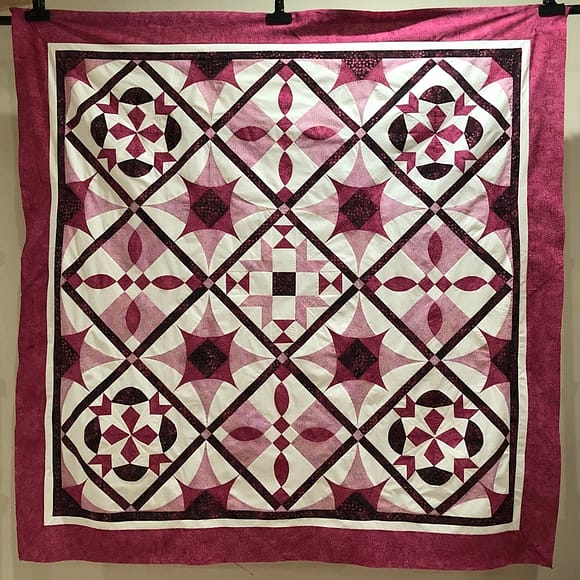
Recently, we reviewed the history of whole cloth quilts and appliqued quilts. What about pieced quilts? Pieced quilting has also been around for a very long time – possibly since the Middle Ages.
The earliest verified forms of pieced quilting are English Paper Piecing from the early 1700s. Pieces of paper are cut into the desired shapes. Fabric is basted around the paper shapes, which provide stability. Then, the pieces are sewn together. Once sewn together, the papers are removed… well most of the time. The papers left inside are how scholars have been able to easily date some of the quilts.
English paper piecing is still a very accurate form of piecing. Today, we use templates and foundation papers as other methods to achieve similar accuracy. Templates help create accurate shapes, but still rely upon someone’s sewing skills to create crisp pieces. Foundation papers provide more precision as the pieces are sewn to the the paper. Personally, I love foundation piecing as it gives me the sharpest points, with the least effort!
American patchwork is another form of piecing. This began with the thrifty use of fabrics, since they were so expensive. People didn’t dare waste fabric, so scraps from sewing clothing were often used for quilts. Even older clothing was used for quilts, when it couldn’t be cut down for other garments. My mom often talked about her mother remaking clothes to fit her kids as they grew. Girls learned to quilt at a young age and often made several for their hope chest.
American patchwork has many facets. One of the most prominent forms is Amish Quilting. The Amish believe in the simple life and shun external influences such as art. Quilting is allowed as it is also utilitarian – a quilt provides necessary warmth. These quilts are unique as most are hand sewn and hand quilted. They typically have simple geometric designs and bold colors. It is rumored the bold colors initially came from the scraps left from making clothing. Again, quilters are a thrifty bunch and try not to waste.
The invention of the sewing machine in the mid 1800’s made quilting easier. In 1856, Singer introduced a payment plan for sewing machines, which lead to most households having a sewing machine by the turn of the century. Designs became more intricate. Patterns were not only handed down from family members and shared within a community, but they were published in magazines and newspapers.
In the late 1800’s, crazy quilting became the fad as part of the Victorian era. Silks, ribbons, beads, and baubles became more accessible because of industrialization. Also, women had more time as a result of modern conveniences. So they enjoyed expressing themselves with this relatively boundless form of quilting.
Then, came wars and the Great Depression. Quilting became more utilitarian again as wool fabrics were conserved for the military and people were pinching pennies to get by. Once the wars were over, many people lost interest in quilting.
As the US prepared for and celebrated her bicentennial, quilting regained popularity. Maybe it was the spirit of Betsy Ross. Quilting became even easier when Moda introduced precut fabrics like the jelly roll in 2006. Precuts made pieced quilts quicker to make and changed the way many patterns were written. They were written specifically for certain fabric cuts. By 2018, quilting as a multi-billion dollar industry and growing every year in popularity.
I hop you have enjoyed this brief overview and take time to explore the links.
Happy Quilting!
Laureen

Really liked the history of pieced quilting.
It’s nice to know where our quilting habits came from.
Maybe some day you could tell us about thimbles.
great idea!